Well, it wasn’t all lying around by the infinity pool while we were away in Vanuatu – although I must say, doing that was very pleasant… (& contrary to appearances, we had very little rain.)
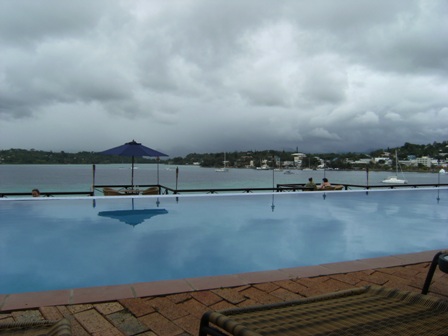
But one of the attractions of going somewhere different is that there is so much new stuff to see and do. And given that we’re both biologists, seeing some of the local wildlife was fairly high on the agenda…
Last time we were in Vanuatu it was August (a few years ago now) & while we had a great time, we were a bit disappointed by the paucity of insect life. We suspected that some of this had to do with the area around the resort we stayed in being sprayed fairly aggressively to control mosquitoes. (Not that anyone was complaining – mozzies there carry malaria, & also I think dengue fever, neither of which are things I want to experience.) But also there weren’t a lot of plants flowering then. This time we were more hopeful.
Certainly there were a lot more plants in flower. But the hibiscus plants made a remarkably poor showing – until we realised that the staff on the island (Iririki) were picking them every morning to adorn the tables. Those flowers that were missed were enormously popular with the butterflies, of which we saw several different species. Alas! they flitted around so fast they were almost impossible to photograph. There’s one making a beeline (or should that be butterfly-line?) for the spectacular centre of the flower below.
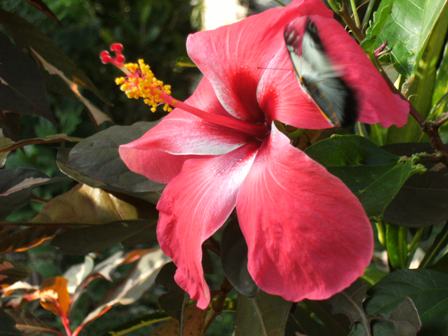
Not all the blossoms we saw were so attractive to the insects. This one, in a garden on the mainland, had no attendants at all, though I stood nearby watching it for quite a while. (Haven’t got round to trying to identify it yet; I did wonder if it might be something that moths would go for, in the evening.)
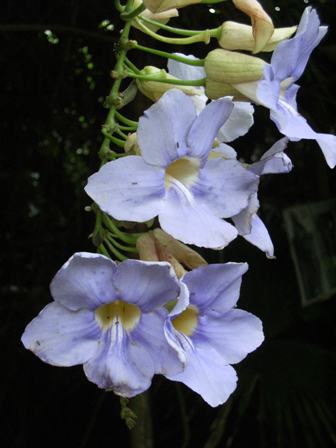
Nor were all the insects quite so mobile – although I could understand that: the heat made us feel quite torpid at times 🙂
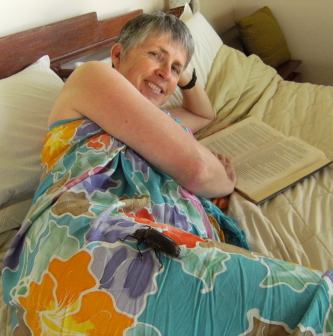
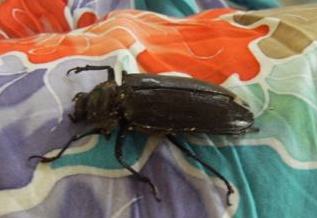
That was the biggest beetle I’ve ever seen. It’s a longhorn beetle, & so related to our own huhu beetles, I suspect. Another arthropod on the island was this hermit crab: it’s living in a land-snail shell, & to give an idea of its size, the shell is about 7cm long.
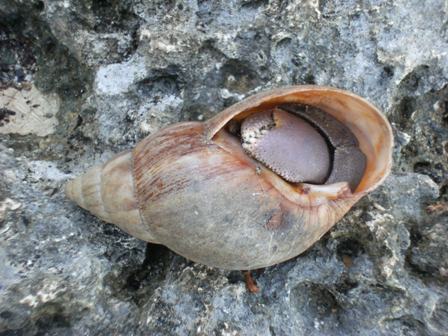
Look at the way that huge front claw blocks the opening of the shell. This is certainly going to deter a hungry predator – or a curious zoologist 🙂 My husband brought this one back from his early-morning fishing expedition: he said there were big hermit crabs like this scrabbling around all over the path he was on, although they’d all disappeared by the time the sun was fully up. Given that the path was a good 10m above sea level & about 20m inland, these are active little things.
We also took the opportunity to see some of the local vertebrates. The garden we visited (the one with the lovely blue flowers) also had a small collection of animals. I felt rather sorry for the flying foxes (perhaps 3 times larger than our own bats), as their cage seemed far too small. They were amazingly agile climbers, swinging up & down the wire netting using their hind feet & the big thumb claws on their wings. Sleeping, they look remarkably like furry chrysalids, pointed at the foot end and with their heads & bellies enveloped within their wings.
The reptiles, on the other hand, looked fairly comfortable.

This is a female banded iguana – confusingly, she’s not banded, but the males have broad pale stripes on the thorax & abdomen. The two we saw were both shedding their skin (that’s what the white patches on her sides are). She had long slender toes & a long whiplike tail, & her skin was soft to the touch. These weren’t the only lizards we saw: there were lots of skinks on Iririki. These were around 10cm long, dark brown with longitudinal yellow stripes along their backs & with the most beautiful blue tails. But they moved so fast we found it impossible to get a photo; we simply couldn’t get close enough.
And best of all – the garden had snakes!
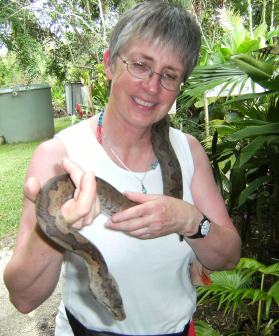
Although New Zealand’s snake-free, I’ve often handled snakes as part of my job. But they’ve all been dead, imported so that we can use them in teaching about vertebrate anatomy. The only live snakes I’d seen before this were sea snakes, & given that they’re venomous I wasn’t about to touch them! But this is a pacific boa, an absolutely beautiful animal with its patterned brown back & a ventral surface covered with larger white, grey & reddish scales. Boas are constrictors & I was much too big for it to be interested in me as a dinner item – the owners told us that it (& the other snakes in its enclosure) ate mice & chicks. (Presumably while there were no tourists around, to avoid upsetting their delicate sensibilities. I remember when Auckland Zoo stopped feeding its monitor lizards live mice, because folks got upset. We do seem to live in a society that likes to be presented with a rather sanitised version of the natural world – yet at the same time seems quite happy to have films & TV with high levels of human violence. I’m not quite sure what that says about us…)
Anyway, handling that snake was such a neat experience. Its skin was soft & dry & slightly warm (presumably from basking, as snakes are what’s commonly called ‘cold-blooded’: their slow basal metabolism means they generate little heat internally, & need to bask in the sun before they can really get going.). And it was strong – I could feel it pushing against me as it flowed through my hands. That really was a very special moment on an all-to-short time away.